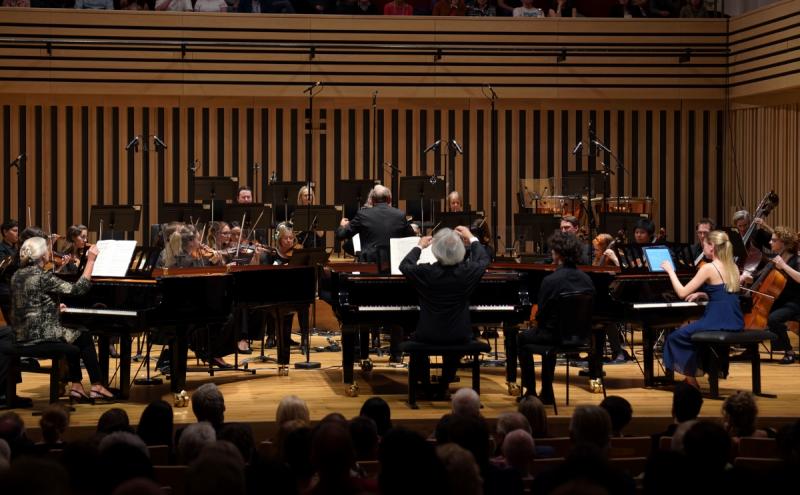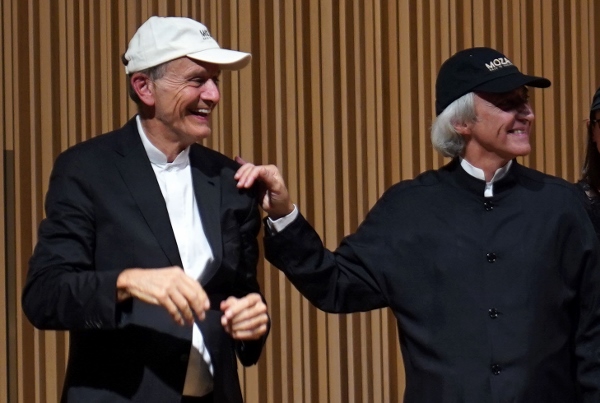Bavouzet, Nemecz, McLachlan, Manchester Camerata, Takács-Nagy, Stoller Hall, Manchester review - finish line of a remarkable marathon | reviews, news & interviews
Bavouzet, Nemecz, McLachlan, Manchester Camerata, Takács-Nagy, Stoller Hall, Manchester review - finish line of a remarkable marathon
Bavouzet, Nemecz, McLachlan, Manchester Camerata, Takács-Nagy, Stoller Hall, Manchester review - finish line of a remarkable marathon
Triumphant conclusion for ‘Mozart, made in Manchester’ piano concertos series

“Mozart, made in Manchester”, the project to perform and record an edition of the piano concertos plus all the opera overtures, seemed a distant destination and an unlikely marathon when Manchester Camerata embarked on it eight years ago.
But with Jean-Efflam Bavouzet and Gábor Takács-Nagy sticking with it through thick and thin (including Covid), they got to the final tape last night at the Stoller Hall in Chetham’s School of Music. The hall didn’t even exist when it all began: the first performances were at the Royal Northern College of Music. But the idea has slowly taken flight and captured audience imaginations, and the final concert – including the two-piano concerto (No. 10) and the three-piano concerto (No. 7) – was not just a triumphant conclusion but had something of a party atmosphere.
After a quarter of an hour of speeches of thanks and rounds of applause, the music began with the overture to La finta semplice. Takács-Nagy (whose multi-coloured highlighting of his conducting scores is a thing to behold, even from the back of a hall), found all the multi-coloured contrasts in its three brief movements that he so often creates: explosive emphases, plenty of sheer exuberance and a touch of playfulness. The Camerata, led by Caroline Pether, were as alert to his promptings as ever.
Then it was Bavouzet’s first solo appearance (of four in the evening), in the Concert-Rondo in A (K386). It’s a surprisingly laid-back, moderate-tempo piece, all suavity and melodies tumbling one after another, and he brought a guilelessness and simplicity to it that fitted the task perfectly. The two-piano concerto (K365) introduced us to Andrea Nemecz – aka Mme Bavouzet – whose presence behind the scenes has been very much a part of the project, but this time she was solo-duettist along with her husband. The pianos were set at the front of the platform (suitably extended into the hall in the way it’s designed to be to accommodate a large symphony orchestra on occasion) in an inverted V-shape, with the soloists, backs to the audience, able to see at least each other’s arms, and the synchronicity of the two together was total. In the opening movement, Mozart hardly gives them more than half a bar when they must play with one voice, but there are challenges in the joint chording and common scales of the slow movement (necessarily meaning just a few opportunities for tempo-bending, but those there are were subtly and skilfully taken), and Rachael Clegg’s oboe solos shone brightly. The finale, a jogging kind of allegro with a lot of fun built in, included some thrilling crescendos and was adorned with a joint cadenza precise in every respect and beautifully braked at its conclusion.
The two-piano concerto (K365) introduced us to Andrea Nemecz – aka Mme Bavouzet – whose presence behind the scenes has been very much a part of the project, but this time she was solo-duettist along with her husband. The pianos were set at the front of the platform (suitably extended into the hall in the way it’s designed to be to accommodate a large symphony orchestra on occasion) in an inverted V-shape, with the soloists, backs to the audience, able to see at least each other’s arms, and the synchronicity of the two together was total. In the opening movement, Mozart hardly gives them more than half a bar when they must play with one voice, but there are challenges in the joint chording and common scales of the slow movement (necessarily meaning just a few opportunities for tempo-bending, but those there are were subtly and skilfully taken), and Rachael Clegg’s oboe solos shone brightly. The finale, a jogging kind of allegro with a lot of fun built in, included some thrilling crescendos and was adorned with a joint cadenza precise in every respect and beautifully braked at its conclusion.
The second part of the programme opened with the Idomeneo overture. It’s made to quieten at the end, but Gábor Takács-Nagy found a host of interesting details along the way. The other Concert-Rondo (in D, K382) is an unusual beast – more a set of variations than what we usually know as a rondo, and the outline and harmonies of the basic theme become a little over-familiar by the end. But Jean-Efflam Bavouzet found a way of treating its many appoggiature-style melodic inflexions with gradually greater emphases, which illuminated things considerably.
The later stages of the “Mozart, made in Manchester” project have been afforded opportunities for a few young string players from Chetham’s School of Music to join the orchestra for each of the concerts, and that was the case again. The Chetham’s-Camerata co-operative concept was extended further – and fruitfully – in the three-piano concerto, as M and Mme Bavouzet were joined by Rose McLachlan as soloists, this time with the three pianos like petals of a flower across the front of the platform.
The series has always been characterised by a productive meeting of minds from its two main creators (pictured above in party mood), and to hear the two expanded to four was rewarding indeed – and a remarkable example of mental unanimity. Takács-Nagy made the opening of the adagio movement an eloquent interlude, and – thanks to Mozart – there was constant delight and fascination in the interweaving of the three pianos’ lines.
And the good news is: they aren’t done yet. The next stage of the project (with Chandos continuing to record the results) is to be the four horn concertos, with soloist Martin Owen.
rating
Explore topics
Share this article
The future of Arts Journalism
You can stop theartsdesk.com closing!
We urgently need financing to survive. Our fundraising drive has thus far raised £49,000 but we need to reach £100,000 or we will be forced to close. Please contribute here: https://gofund.me/c3f6033d
And if you can forward this information to anyone who might assist, we’d be grateful.

Subscribe to theartsdesk.com
Thank you for continuing to read our work on theartsdesk.com. For unlimited access to every article in its entirety, including our archive of more than 15,000 pieces, we're asking for £5 per month or £40 per year. We feel it's a very good deal, and hope you do too.
To take a subscription now simply click here.
And if you're looking for that extra gift for a friend or family member, why not treat them to a theartsdesk.com gift subscription?
more Classical music
 Lammermuir Festival 2025 review - music with soul from the heart of East Lothian
Baroque splendour, and chamber-ensemble drama, amid history-haunted lands
Lammermuir Festival 2025 review - music with soul from the heart of East Lothian
Baroque splendour, and chamber-ensemble drama, amid history-haunted lands
 BBC Proms: Steinbacher, RPO, Petrenko / Sternath, BBCSO, Oramo review - double-bill mixed bag
Young pianist shines in Grieg but Bliss’s portentous cantata disappoints
BBC Proms: Steinbacher, RPO, Petrenko / Sternath, BBCSO, Oramo review - double-bill mixed bag
Young pianist shines in Grieg but Bliss’s portentous cantata disappoints
 theartsdesk at the Lahti Sibelius Festival - early epics by the Finnish master in context
Finnish heroes meet their Austro-German counterparts in breathtaking interpretations
theartsdesk at the Lahti Sibelius Festival - early epics by the Finnish master in context
Finnish heroes meet their Austro-German counterparts in breathtaking interpretations
 Classical CDs: Sleigh rides, pancakes and cigars
Two big boxes, plus new music for brass and a pair of clarinet concertos
Classical CDs: Sleigh rides, pancakes and cigars
Two big boxes, plus new music for brass and a pair of clarinet concertos
 Waley-Cohen, Manchester Camerata, Pether, Whitworth Art Gallery, Manchester review - premiere of no ordinary violin concerto
Images of maternal care inspired by Hepworth and played in a gallery setting
Waley-Cohen, Manchester Camerata, Pether, Whitworth Art Gallery, Manchester review - premiere of no ordinary violin concerto
Images of maternal care inspired by Hepworth and played in a gallery setting
 BBC Proms: Barruk, Norwegian Chamber Orchestra, Kuusisto review - vague incantations, precise laments
First-half mix of Sámi songs and string things falters, but Shostakovich scours the soul
BBC Proms: Barruk, Norwegian Chamber Orchestra, Kuusisto review - vague incantations, precise laments
First-half mix of Sámi songs and string things falters, but Shostakovich scours the soul
 BBC Proms: Alexander’s Feast, Irish Baroque Orchestra, Whelan review - rapturous Handel fills the space
Pure joy, with a touch of introspection, from a great ensemble and three superb soloists
BBC Proms: Alexander’s Feast, Irish Baroque Orchestra, Whelan review - rapturous Handel fills the space
Pure joy, with a touch of introspection, from a great ensemble and three superb soloists
 BBC Proms: Moore, LSO, Bancroft review - the freshness of morning wind and brass
English concert band music...and an outlier
BBC Proms: Moore, LSO, Bancroft review - the freshness of morning wind and brass
English concert band music...and an outlier
 Willis-Sørensen, Ukrainian Freedom Orchestra, Wilson, Cadogan Hall review - romantic resilience
Passion, and polish, from Kyiv's musical warriors
Willis-Sørensen, Ukrainian Freedom Orchestra, Wilson, Cadogan Hall review - romantic resilience
Passion, and polish, from Kyiv's musical warriors
 BBC Proms: Faust, Gewandhausorchester Leipzig, Nelsons review - grace, then grandeur
A great fiddler lightens a dense orchestral palette
BBC Proms: Faust, Gewandhausorchester Leipzig, Nelsons review - grace, then grandeur
A great fiddler lightens a dense orchestral palette
 BBC Proms: Jansen, Royal Concertgebouw Orchestra, Mäkelä review - confirming a phenomenon
Second Prom of a great orchestra and chief conductor in waiting never puts a foot wrong
BBC Proms: Jansen, Royal Concertgebouw Orchestra, Mäkelä review - confirming a phenomenon
Second Prom of a great orchestra and chief conductor in waiting never puts a foot wrong
 BBC Proms: Royal Concertgebouw Orchestra, Mäkelä review - defiantly introverted Mahler 5 gives food for thought
Chief Conductor in Waiting has supple, nuanced chemistry with a great orchestra
BBC Proms: Royal Concertgebouw Orchestra, Mäkelä review - defiantly introverted Mahler 5 gives food for thought
Chief Conductor in Waiting has supple, nuanced chemistry with a great orchestra

Add comment